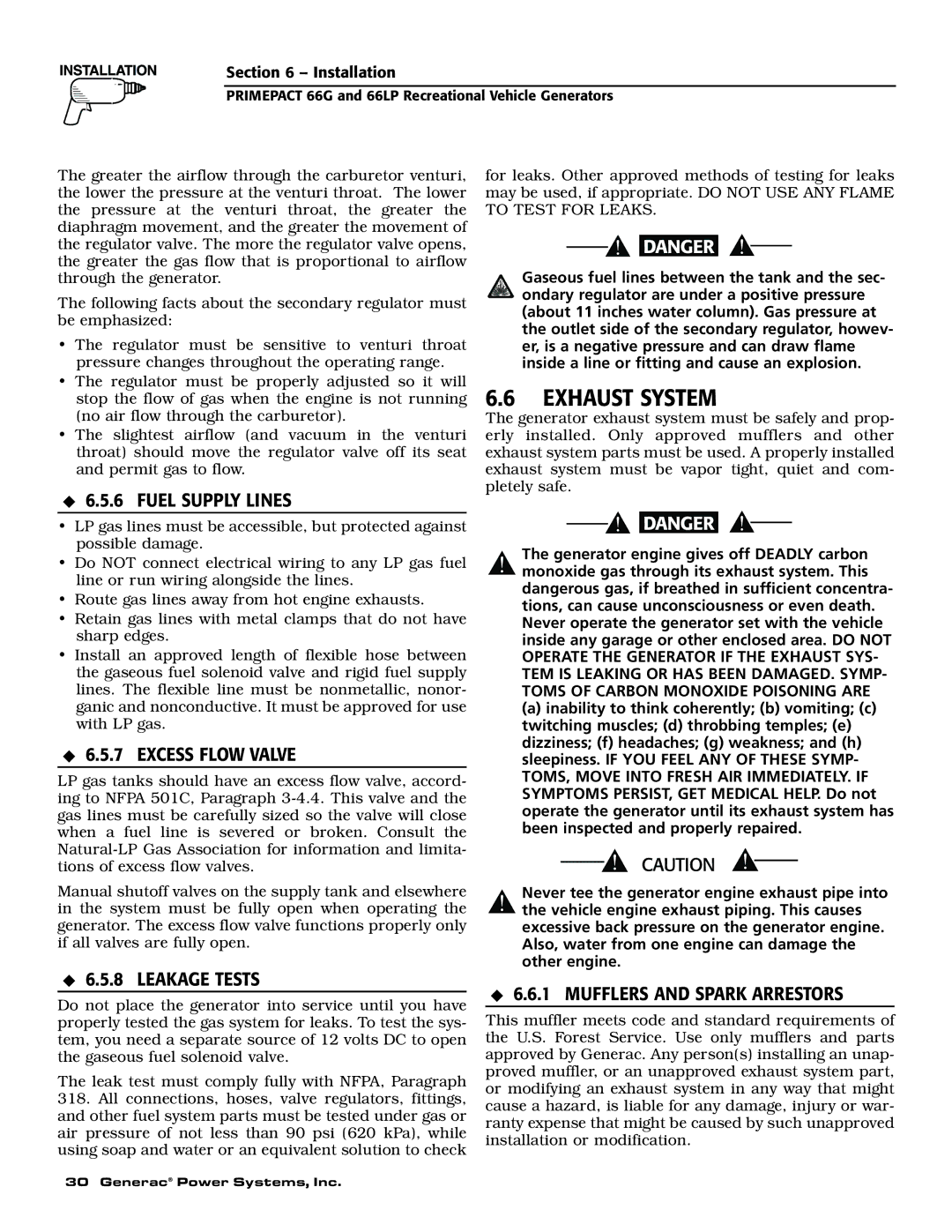
Section 6 – Installation
PRIMEPACT 66G and 66LP Recreational Vehicle Generators
The greater the airflow through the carburetor venturi, the lower the pressure at the venturi throat. The lower the pressure at the venturi throat, the greater the diaphragm movement, and the greater the movement of the regulator valve. The more the regulator valve opens, the greater the gas flow that is proportional to airflow through the generator.
The following facts about the secondary regulator must be emphasized:
•The regulator must be sensitive to venturi throat pressure changes throughout the operating range.
•The regulator must be properly adjusted so it will stop the flow of gas when the engine is not running (no air flow through the carburetor).
•The slightest airflow (and vacuum in the venturi throat) should move the regulator valve off its seat and permit gas to flow.
◆6.5.6 FUEL SUPPLY LINES
•LP gas lines must be accessible, but protected against possible damage.
•Do NOT connect electrical wiring to any LP gas fuel line or run wiring alongside the lines.
•Route gas lines away from hot engine exhausts.
•Retain gas lines with metal clamps that do not have sharp edges.
•Install an approved length of flexible hose between the gaseous fuel solenoid valve and rigid fuel supply lines. The flexible line must be nonmetallic, nonor- ganic and nonconductive. It must be approved for use with LP gas.
◆6.5.7 EXCESS FLOW VALVE
LP gas tanks should have an excess flow valve, accord- ing to NFPA 501C, Paragraph
Manual shutoff valves on the supply tank and elsewhere in the system must be fully open when operating the generator. The excess flow valve functions properly only if all valves are fully open.
for leaks. Other approved methods of testing for leaks may be used, if appropriate. DO NOT USE ANY FLAME TO TEST FOR LEAKS.
Gaseous fuel lines between the tank and the sec- ondary regulator are under a positive pressure (about 11 inches water column). Gas pressure at the outlet side of the secondary regulator, howev- er, is a negative pressure and can draw flame inside a line or fitting and cause an explosion.
6.6EXHAUST SYSTEM
The generator exhaust system must be safely and prop- erly installed. Only approved mufflers and other exhaust system parts must be used. A properly installed exhaust system must be vapor tight, quiet and com- pletely safe.
The generator engine gives off DEADLY carbon monoxide gas through its exhaust system. This dangerous gas, if breathed in sufficient concentra- tions, can cause unconsciousness or even death. Never operate the generator set with the vehicle inside any garage or other enclosed area. DO NOT OPERATE THE GENERATOR IF THE EXHAUST SYS- TEM IS LEAKING OR HAS BEEN DAMAGED. SYMP- TOMS OF CARBON MONOXIDE POISONING ARE
(a)inability to think coherently; (b) vomiting; (c) twitching muscles; (d) throbbing temples; (e) dizziness; (f) headaches; (g) weakness; and (h) sleepiness. IF YOU FEEL ANY OF THESE SYMP-
TOMS, MOVE INTO FRESH AIR IMMEDIATELY. IF SYMPTOMS PERSIST, GET MEDICAL HELP. Do not operate the generator until its exhaust system has been inspected and properly repaired.
Never tee the generator engine exhaust pipe into the vehicle engine exhaust piping. This causes excessive back pressure on the generator engine. Also, water from one engine can damage the other engine.
◆6.5.8 LEAKAGE TESTS
Do not place the generator into service until you have properly tested the gas system for leaks. To test the sys- tem, you need a separate source of 12 volts DC to open the gaseous fuel solenoid valve.
The leak test must comply fully with NFPA, Paragraph
318.All connections, hoses, valve regulators, fittings, and other fuel system parts must be tested under gas or air pressure of not less than 90 psi (620 kPa), while using soap and water or an equivalent solution to check
◆6.6.1 MUFFLERS AND SPARK ARRESTORS
This muffler meets code and standard requirements of the U.S. Forest Service. Use only mufflers and parts approved by Generac. Any person(s) installing an unap- proved muffler, or an unapproved exhaust system part, or modifying an exhaust system in any way that might cause a hazard, is liable for any damage, injury or war- ranty expense that might be caused by such unapproved installation or modification.
30 Generac® Power Systems, Inc.
